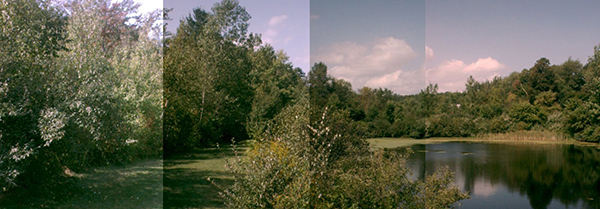
by John Copeland Wednesday, August 16, 2017

Panaoramic color photograph made at Fredonian Nature Center in Shirley, Massachusetts, at the fall equinox, September 22, 2002. Credit: Bob Burkhardt, CC BY 3.0
Last month, many of us in the U.S. celebrated a relatively rare event — a full solar eclipse. That event, and the fact that the metal roof of my ranch house in California’s Santa Ynez Valley has started resonating with the thunk of raining acorns, got me thinking about our annual trip around the sun and the impending fall equinox.
Thursday, Sept. 21, is the “last day of summer” for us in the Northern Hemisphere. Friday, Sept. 22, is the autumn equinox and the first day of fall. Although the equinox happens at the same moment worldwide, the time of its arrival depends on where you are. Here in California, fall will be ushered in at 1:02 p.m. PDT; for those on the U.S. East Coast, it’ll be at 4:02 p.m. If you live in the Southern Hemisphere, instead of fall it will be the first day of spring.
Equinoxes are astronomical events, caused by Earth’s tilt on its axis and orbit around the sun. Because Earth doesn’t orbit upright, but is tilted on its axis by 23 and a half degrees, over the course of the year’s orbit, the Northern and Southern hemispheres alternate in receiving the sun’s light and warmth most directly. In the fall, as the Earth moves along in its orbit, the tilt of the North Pole begins to aim away from the sun. Cooler weather comes to the Northern Hemisphere. Our hours of daylight will continue shortening until the winter solstice in December.
There are two equinoxes every year: in September and March, when the sun shines directly on the equator and the length of day and night in the Northern and Southern hemispheres is nearly equal — but not quite. Because the word “equinox” comes from two Latin words “aequus” (equal) and “nox” (night), you might logically think that equinox would mean that the lengths of day and night are equal. But in Santa Ynez, day and night aren’t equal until Sept. 26; on Sept. 22, their durations are about six minutes different, with day being longer.
You can check for the exact “equinox” date where you live by looking up sunrise and sunset times for your location. The reason it does not occur at the equinox is because sunrise and sunset are measured from the edges of the sun and not its geometric center. Sunrise begins the moment the upper edge of the disk becomes visible on the horizon; likewise sunset is the last moment the upper edge is visible before it dips below the horizon. The extra few minutes it takes the sun to fully rise and set is considered daytime, thus the longer day length.The diffraction of sunlight as it passes through Earth’s atmosphere is also a factor.
You may have noticed that the dates of the two equinoxes, autumn and spring, can vary from year to year. The autumn equinox usually occurs on Sept. 21 or Sept. 22. But in 1931, the autumn equinox was on Sept. 24, and that won’t happen again until 2303. The equinox would fall on exactly the same day each year if Earth completed its orbit in exactly 365 days, as our calendar shows. But it actually takes 365.25 days. That extra quarter day means that the equinoxes occur six hours later each year, which pushes the date of the equinox around from year to year.
I like to think that the equinox is also about balance, and the autumn equinox occurs as the sun enters the astrological sign of Libra, the scales. When fall begins for the Northern Hemisphere, spring begins for the Southern Hemisphere. For a little while, days will be balanced with light and darkness, and temperatures are milder.
Our early ancestors understood this balance better than anyone, I suspect. They used the sky as both a clock and a calendar. They could easily see that the sun’s path across the sky, the length of daylight, and the location of the sunrise and sunset shift in a regular way throughout the year. If you go outside at sunrise or sunset on the equinox, you will see, as our ancestors did, an astronomical event of immense significance to ancient peoples: the astronomical alignment of the sun rising directly in the East and setting directly in the West. This event occurs only twice a year, on the autumnal and vernal equinoxes. On these two days, you can mark the exact directions of East and West using the sun.
The autumn equinox is also closely associated with harvest time. The full moon closest to the autumn equinox is known as the Harvest Moon, since farmers were able to harvest their crops during the night with the light of the full moon to aid them. Throughout history, agrarian cultures have celebrated the year’s harvest. Even today, people enjoy fall festivals as they sense the closure of the summer season and the coming of a long winter. So, get out and enjoy them. Winter is coming.
© 2008-2021. All rights reserved. Any copying, redistribution or retransmission of any of the contents of this service without the expressed written permission of the American Geosciences Institute is expressly prohibited. Click here for all copyright requests.